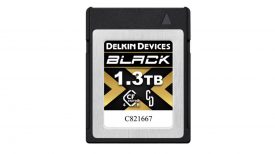By technical editor Matt Allard:
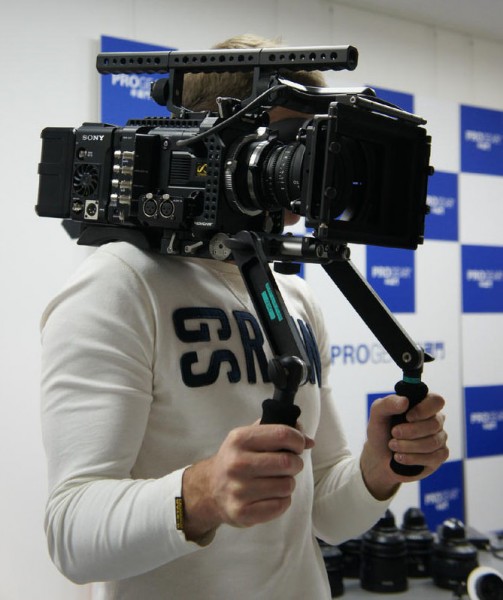
Today in Tokyo I was lucky enough to get some hands-on time with the new Sony F55 as well as all the latest accessories, including the new Sony PL lenses.
I own both a PMW-F3 and a FS700, so I was very keen to see how far Sony has progressed with the F range. The first thing that strikes you is how small the F55 camera body is. It is extremely modular and easy to transport; you could easily fit the camera into a backpack. They showed a photo of a guy carrying three F55 bodies in a carry-on bag! It looks very light but in reality it isn’t; I would say it weighs about the same as a F3 body. The build quality is fairly good.
I found the camera design to be very good. Everything was easy to find and the key camera functions are accessible without having to go into deep menus. Even as a first time user of the camera, it is very easy to get it turned on and shoot quickly. There is one major design flaw: the connection cable for the new Sony OLED or LED viewfinder sticks straight out the side of the camera. While it is reasonably secure, it would be easier to knock and broken given this placement. Making the connector a right-angled one would have helped. Even Takashi Irikura (Senior Marketing Manager) for Sony appeared to agree that it wasn’t a good design.
I was able to hook the camera up to the Sony PVM-X300 4K display and look very closely at things such as the global shutter, noise and dynamic range.
The F55’s global shutter really is brilliant and revolutionary in a camera at this price – gone are the jello-like images of a conventional CMOS sensor. The dynamic range was also superb – according to Sony it is 14 stops. One thing that blew me away was the noise – or lack of it. The F55 is rated at 1250 ISO (in S-Log 2) and can be pushed to 10,000 ISO. I didn’t go deeper into the menus to see if it can go beyond 10,000 ISO – that is something I still need to check. I was allowed to record some F55 vision but unfortunately I’m not allowed to post it. I did quite a few tests in low light conditions at 10,000 ISO and was amazed at how clean it was. Pixel peeping on a 4K display I struggled to see any noise. I would have expected to see a lot more noise than I did.
On a 4K display, the images were extremely detailed and sharp and had beautiful colour rendition. One of the great things about the F55 is the ability to view 4K straight out of the camera via the 4 HD-SDI outputs on the side of the camera. This is great if you can afford the $20,000+ 4K monitor!
Perhaps most interesting was the behind-the-scenes footage of a music video that was shot here in Japan on the F55. It was shot in camera at 4K but for HD distribution. Because 4K is basically four times the resolution of HD, the director and DP could film a lot of the shots wide and perform all the zooms and camera movements in post. This method saves time on location and gives the production a lot more flexibility. One static shot can become a wide, a mid and a tight – or a pan or tilt or zoom – all from the one shot. I see this becoming very popular with people shooting music videos and documentaries, turning one shot into many.
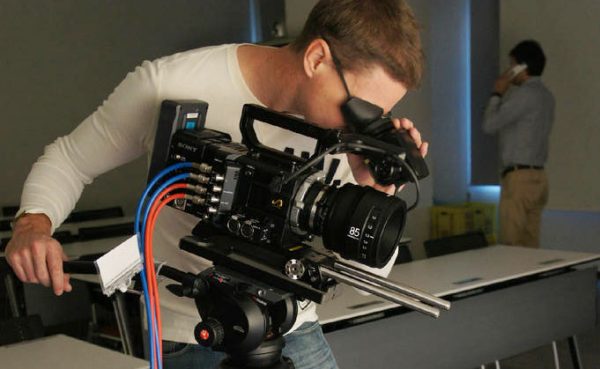
There are two viewfinder options, the OLED version and the LCD version which can also be used as a small monitor. Being used to third party EVFs I was shocked at just how good the OLED viewfinder was. I have used a variety of professional viewfinders over the last 20+ years and this was by far the best one I have ever seen. It shows gorgeous colour rendition, is tack sharp and has deep blacks. I didn’t feel I was ever left in any doubt whether the image was in focus or not. It also features a 2x magnification button – although I couldn’t find a way to move the magnified point as you can on other cameras. You can choose in the menu to have peaking on or off, tweak the amount and colour of the peaking and set your zebras to any level you like. One glaring omission: there is no histogram – totally bizarre given how important it is when trying to judge whether your highlights are blown out. Sony is considering adding a histogram in the next firmware release. I also suggested they should include false colour.
Unfortunately I think Sony have shot themselves in the foot again when it comes to firmware. No, you’re not going to have to pay for it (lesson learnt there from the F3 S-Log debacle) but this time the issue is when it will be released and what it will include. My initial thought when I heard the news was “What the ?????” No wonder none of this information I’m about to tell you is readily known. If it was, I think people would be very angry.
So here we go. If you are planning on buying a F55 or F5 here is some very important information that you need to know. None of the high frame rates above 60p in HD XAVC will be available until the release of the first firmware update – currently scheduled for the end of September 2013. So the 120, 180 and 240fps that were so highly touted as features when the camera was announced won’t be available till the end of September. Huh??? If I buy the F55 I won’t have access to high frame rates for another 8 months! What on earth are Sony thinking? I cannot get my head around this at all. Other features you need to wait for until the end of September are the ability to record the SR Codec internally as well as WiFi control of the camera from a iPad or iPhone.
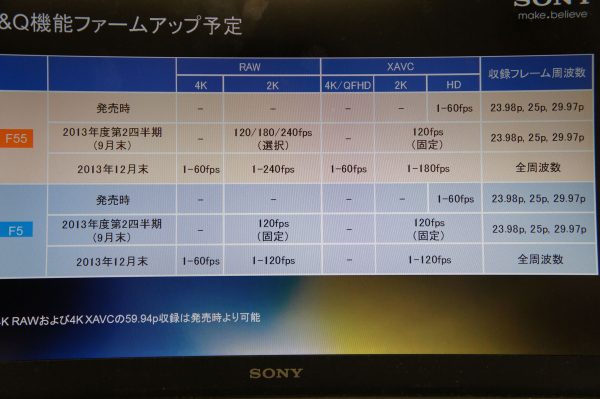
I believe there will be a second firmware update planned for December that will include mostly under- and over-crank (S&Q) abilities. 1-60fps in 4K RAW, 1-240fps in 2K RAW , 1-60fps in 4K/QFHD (the internally recorded 4K option), 1-180fps in 2K and HD XAVC. It will also enable EI S-Log, monitor LUTs and user matrix settings.
I could understand these firmware releases if they were due out maybe a month after release – but keeping them till September and December is pure madness. Hopefully if enough people complain this can be changed.
On a more positive note I discovered that the new Ovaline batteries last about 1.5x longer than regular V-lock batteries and will also charge in half the time – if you purchase the new Sony dual charger. This charger only does one battery at a time and is the size of a 15″ laptop! Why it has to be so big and why it only charges one battery at a time is beyond me. You can of course use your existing V-lock batteries and chargers if you like. The new batteries will apparently charge on old chargers, but you won’t get the benefit of quicker charge times.
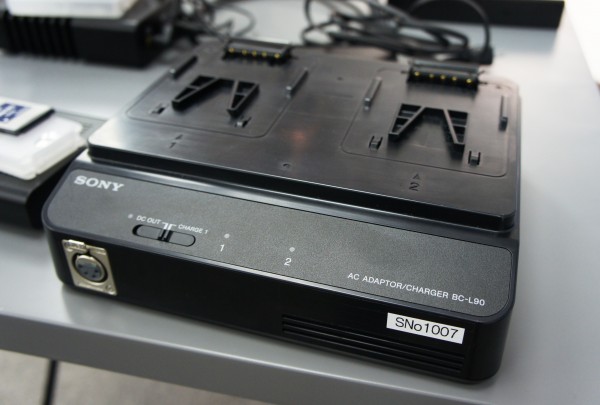
Speaking of power, the additional AXS-R5 RAW recorder module draws as much power as the camera itself. So, when using the RAW recorder, just keep in mind that the battery life will be halved. The AXS-R5 is however extremely light and very compact.
The FS700 adaptor for the AXS-R5 recorder will be released in June. This will enable a 4K RAW output to be recorded from the FS700. Price is yet to be announced.
As far as media goes, a lot of people have been wondering what the price of the new SxS Pro+ cards will be. The Japanese prices are as follows: The 128GB cards are around $1300 US, the 64GB card around $870 US.
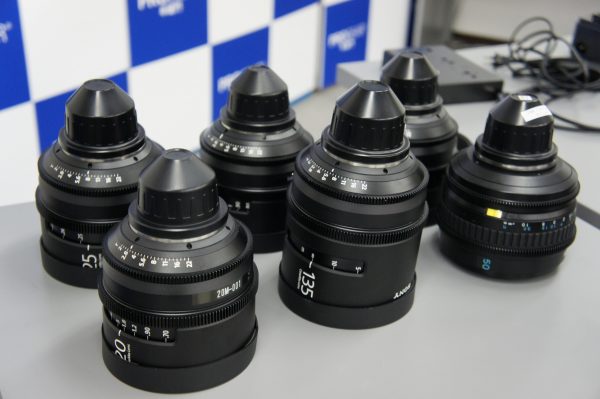
I also managed to try out the new Sony PL mount cine lenses. They are a lot bigger and heavier than the previous ones that were originally available for purchase with the F3 and are now made out of metal instead of hard plastic, but retain the same T2 speed. Optically, I was not able to compare whether they were any better than the original Sony PL lenses. They did seem to be very sharp from the time I spent using them. They will be available as either a set of six (20, 25, 35, 50, 85 and 135mm) or as a set of three (20, 25 and 135mm). This last option is for people who have already originally purchased the PL lens set with the F3. I was not able to get any clarification on whether they will be available to purchase separately. The six lens set will retail for around $25,000US and the three lens set around $14,000 US.
On the subject of lenses: if you plan on using the Sony 18-252mm servo zoom lens on the F55/5 you will be able to buy a CBK-DCB01 demand converter box that will be able to go between the remote port on the camera and a zoom controller such as those made by Canon for broadcast cameras. This will also be available in June and will enable you to use servo zoom operation. Price will be around $1300US.
I also managed to try out the new F55 rig from Movcam. I am a big fan of the current Movcam product range – I use their rigs daily on my F3 and FS700. Even Sony’s Takashi Irikura was very impressed with the balance and build quality. I had the F55 on my shoulder and found it very easy to use hand-held. Having that proper viewfinder too, makes a huge difference.
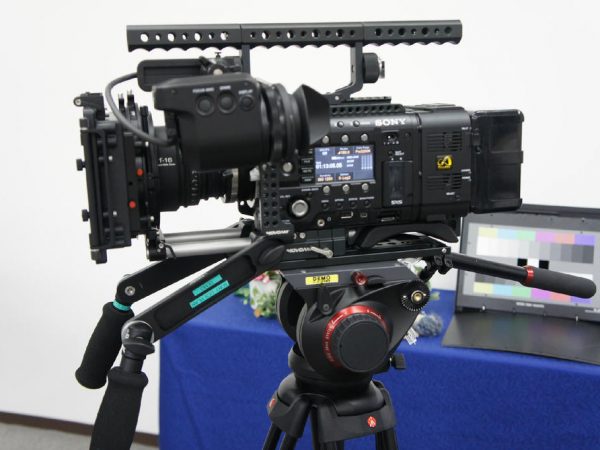
My overall impressions of this camera are mostly positive. A fantastic image, versatility in recording formats, great view finders, compact size – and it’s absolutely superb in low light. The global shutter and colour gamut of the F55 really make this camera a very enticing proposition. The downsides are the ridiculous waiting times for firmware updates and the glaring omission of key features at release.
Sony have ultimately made an outstanding camera that packs a punch, but will leave a sour taste in the mouths of owners who will have to wait almost eight months to savour features that should be included at launch.
About Matthew Allard, Aljazeera Team Leader Cameras, Kuala Lumpur:
Matt has been a Camera/Editor in TV news for more 22 years, previously working for both Channel 9 and Channel 10 in Australia. Twice Network Ten Australia’s cameraman of the year as well as being a Walkley Finalist for outstanding camerawork in 2006 (for coverage of the Cronulla Race Riots) and a Logie Finalist for outstanding news coverage 2006 (Bali 9). He has won 14 ACS (Australian Cinematographers Society) awards. His Sword Maker story that was shot on a 7D won the prestigious Neil Davis International News Golden Tripod at the 2011 ACS Awards. He has covered news events in more than 35 countries, from major sporting events to terrorist bombings. Based out of the Kuala Lumpur broadcast centre in Malaysia he is an avid user and follower of new technology, shooting stories on HD broadcast cameras, the Sony FS700 and F3 as well as Canon DSLRs.




